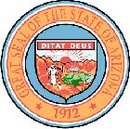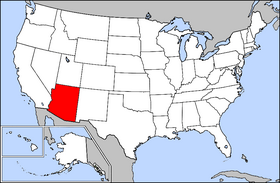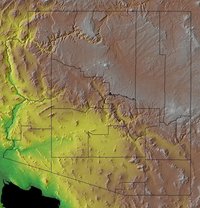Arizona
|
|
| ||||||||||||||||||||||||||||||||||||||||||||||||||||||||||||||||
Arizona was the 48th state admitted to the United States and is part of the Southwest United States. It is one of the Four Corners states, south and east of the Colorado River, bordering New Mexico, Utah, Nevada, California and Mexico, and touching Colorado. It is also the name of a US Battleship, the USS Arizona.
Its major cities are Phoenix, Tucson, Yuma, and Flagstaff. Besides the Grand Canyon, a number of other National Forests, Parks, Monuments, and Indian reservations are located in the state.
Historians disagree about the origin of the name "Arizona" and its attachment to the region. Three possible derivations are:
- O'odham words "alĭ ṣon" ("small spring"), actually the name of a town which is called "Arizonac" in English. Arizonac is a small town about 12 km/eight miles south of the United States-Mexican border. Historically, it may have been "alĭ son" or even "alĭ sona". The O'odham "l" is a voiced alveolar lateral fricative, which might sound to a Spanish or English speaker like an "r" sound. Later in the mid 18th century Spanish missionaries changed Father Eusebio Francisco Kino's maps of the area; they renamed the town Arizonac as Arizona. As the maps were republished and circulated in Europe, the name Arizona became attached to the whole northern part of New Spain.
- Spanish words "Ჩda zona" ("arid zone")
- Nahuatl word "arizuma" ("silver bearing"). In 1736, a small silver-mining camp called "Real Arissona" by the Spanish was established near Arizonac.
USS Arizona was named in honor of this state.
| Contents |
History
Beyond its original native inhabitants, Marcos de Niza, a Franciscan, explored the area in 1539. Coronado's expedition entered the area in 1540–42 during its search for Cibola. Father Kino developed a chain of missions and taught the Indians Christianity in Pimer�Alta (now southern Arizona and northern Sonora) in the 1690's and early 1700's. Spain founded fortified towns (presidios) at Tubac in 1752 and Tucson in 1775. All of what is now Arizona became part of Mexico's northwest frontier upon the Mexican assertion of independence from Spain in 1810. The United States took possession of most of Arizona at the end of the Mexican War in 1848. In 1853 the land below the Gila River was acquired from Mexico in the Gadsden Purchase. Arizona was administered as part of the Territory of New Mexico until it was organized into a separate territory on February 24, 1863.
With the encouragement of Brigham Young, Mormons went to Arizona from Utah in the mid to late 1800s to the Phoenix Valley (or "Valley of the Sun"), Mesa, Tempe, Prescott, Snowflake, Heber, and many other Arizona towns to settle there.
Arizona was also the site of a German and Italian prisoner of war camp during WWII. The site was purchased after the war by the Maytag family, and is currently the Phoenix Zoo.
Arizona was admitted into the Union on February 14, 1912.
Law and government
See: List of Congressmen
Arizona's legislature consists of a thirty-member Senate and a 60-member House of Representatives. The majority party is the Republican party, which has held power since 1950. The 2002 budget of the Arizona state legislature was $14.3 billion, while the executive budget was $13.8 billion. Besides the money spent on state agencies, money has also been allocated for tax cuts, pay raises for government employees, and health insurance for government employees. The executive budget has allocated money to previously passed legislation. Arizona state senators and representatives are elected for two year terms and there are no terms limits. However, no more than four terms may be served consecutively.
Arizona's executive branch is headed by a governor elected for a four-year term. The governor may serve any number of terms, though no more than two in a row. The current Governor of Arizona is Janet Napolitano, a Democrat. She has been governor since 2003. See:List of Arizona Governors
The two Arizona US Senators are Senator John McCain (Republican) and Senator Jon Kyl (Republican).
Arizona's representatives in the United States House of Representatives are Rick Renzi (R-1), Trent Franks (R-2), John Shadegg (R-3), Ed Pastor (D-4), J.D. Hayworth (R-5), Jeff Flake (R-6), Raul Grijalva (D-7), and Jim Kolbe (R-8). Arizona gained two seats in the House of Representatives due to redistricting based on Census 2000.
Geography
| See: | List of Arizona counties | List of Arizona rivers | List of Arizona lakes |
| Arizona state parks | List of U.S. National Forests |
Like other states of the Southwest, Arizona has an abundance of topographical characteristics in addition to its desert climes. More than half of the state features mountains and plateaus and contains the largest stand of Ponderosa pine in the United States. The Mogollon Rim, a 600-meters (2000-foot) escarpment, cuts across the central section of the state and marks the southwestern edge of the Colorado Plateau, where the state experienced its worst forest fire ever in 2002.
The Grand Canyon is a colorful, steep-sided gorge, carved by the Colorado River, in northern Arizona. The canyon is one of the seven natural wonders of the world and is largely contained in the Grand Canyon National Park - one of the first national parks in the United States. President Theodore Roosevelt was a major proponent of the Grand Canyon area, visiting on numerous occasions to hunt mountain lion and enjoy the breathtaking scenery.
The canyon, created by the Colorado River cutting a channel over millions of years, is about 277 mile (446 km) long, ranges in width from 6 to 29 kilometers (4 to 18 miles) and attains a depth of more than 1,6 km (1 mile). Nearly 2 billion years of the Earth's history has been exposed as the Colorado River and its tributaries cut through layer after layer of sediment as the Colorado Plateaus have uplifted.
- Statistics
- Largest City: Phoenix
- Highest Point: Humphreys Peak - 12,633 ft. near Flagstaff
- Lowest Point: Colorado River - 70 ft.
Art
Arizona has witnessed a continuous string of dancing and performing groups of many ethnicities. The state is a recognized center of Native American art, with a number of galleries such as the Heard Museum showcasing historical and contemporary works. Sedona and Tubac are known as budding artist colonies, and small arts scenes exist in the larger cities and near the state universities.
Many tourist souvenirs produced in Arizona or by its residents display immediately characteristic images, such as sunsets, coyotes, and desert plants. Several major Hollywood films, such as U-Turn, Waiting to Exhale, and Bill and Ted's Excellent Adventure have been made there (as indeed have many Westerns).
Climate
Due to its large area and variations in elevation, the state has a wide variety of climates. In the lower elevations, the climate is primarily desert, with mild winters and hot summers. Typically, from late fall to early spring, the weather is mild, averaging a minimum of 15 degrees Celsius (60 degrees Fahrenheit). November through February are the coldest months with temperatures typically ranging from 4 - 24 degrees Celsius (40-75 degrees Fahrenheit), although occasional frosts are not uncommon. About midway through February, the temperatures start to rise again with sunny warm days, and cool breezy nights. The summer months of May through August bring a dry, heat ranging from 35 to 40 degrees Celsius (the high 90-100s), with occasional high temperatures exceeding 50C (125 F) have been observed in the desert area. Due to the primarily dry climate, large temperature swings often occur between day and night temperatures, with temperature swings as large as 10 C (50 F) in the summer months.
However, the northern third of Arizona is a plateau at signficantly higher altitudes than the lower desert, and has an appreciably cooler climate, with cold winters and mild summers. Extreme cold temperatures are not unknown, cold air systems from the northern states and Canada occasionally push into the state bringing temperatures below -20C ( subzero Fahrenheit) temperatures in the higher parts of the state.
Monsoon season in Arizona is from the end of July through August. The monsoons bring lightning, thunderstorms, wind and torrentious, if usually brief, evening downpours. It is rare for tornadoes to occur in Arizona.
Economy
The 2003 total gross state product was $182 billion. Its per capita income was $27,232, 39th in the United States. Early in its history, Arizona's economy relied on the "five C's": copper, cotton, cattle, citrus and climate (i.e., tourism). At one point Arizona was the largest producer of cotton in the country. Copper is still produced in abundance from many giant open-pit mines and underground mines. The state government is the state's largest employer, while Wal-Mart is the state's largest private employer, with 17,343 employees in 2003. Arizona lost much of its advantage as a high-technology industry leader between 1990 and 2001, according to a state Department of Commerce (http://www.commerce.state.az.us/) report. In 2001, 161,166 Arizonans were employed in the high-tech sector, accounting for about 8.3 percent of total private-sector employment of more than 1.9 million. High-tech payroll in 2001 was $2.2 billion, or 14.7 percent of the private-sector total. High-tech employment was led by software and computers, with 34,314; electronics components manufacturing, 30,358; aerospace manufacturing, 25,641; architectural and engineering services, 21,378; telecommunications, 21,224; and instruments manufacturing, 13,056.
Demographics
As of 2003, Arizona had a population of 5,580,811 according Census Bureau estimates.
The racial breakdown of the state is as follows:
- 63.8% White non-Hispanic
- 25.3% Hispanic
- 5% American Indian
- 3.1% Black
- 1.8% Asian
- 2.9% mixed race
According to 2003 Census esimates, Arizona has the second highest number of Native Americans of any state in the Union. 286,680 reportedly live in Arizona, this represents more than 10% of the country's total Indian population of 2,752,158. Only California has more Indians than Arizona, and Arizona has slightly more Indians than Oklahoma [1] (http://eire.census.gov/popest/data/states/ST-EST2002-ASRO-03.php).
Arizona is likely to become a minority-majority state by the year 2035 at the latest. In 2003, for the first time, there were more Hispanic births in the state than white non-Hispanic births.
As of 2000, 74.1% of Arizona residents age 5 and older speak English at home and 19.5% speak Spanish. Navajo is the third most spoken language at 1.9%, followed by Other Native North American languages at 0.6% and German at 0.5%.
49.9% of the population is male, 50.1% is female.
See also the list of Arizona Natives.
Religion
Four in five Arizonans are self-described Christians, with large numbers of both Catholics and Protestants living in the state. There is also a significant Mormon population.
- 80% Christian
- 2% Non-Christian religions
- 18% No Religion
Important cities and towns
National-atlas-arizona.png
Phoenix_sykline.jpg
City_Street_of_Tucson,_AZ.jpg
See: List of cities in Arizona, List of cities in Arizona (by population), List of Arizona counties
Each city named in bold has a population greater than 100,000.
25 Richest Places in Arizona
Ranked by per capita income
| City | Income | City | Income |
| 1 Paradise Valley, Arizona | $81,290 | 14 Sedona, Arizona | $31,350 |
| 2 Carefree, Arizona | $62,433 | 15 Green Valley, Arizona | $31,138 |
| 3 Rio Verde, Arizona | $58,783 | 16 Oro Valley, Arizona | $31,134 |
| 4 Tubac, Arizona | $46,643 | 17 Williamson, Arizona | $30,232 |
| 5 Catalina Foothills, Arizona | $42,006 | 18 Big Park, Arizona | $30,026 |
| 6 Scottsdale, Arizona | $39,158 | 19 Queen Valley, Arizona | $28,886 |
| 7 Cave Creek, Arizona | $38,070 | 20 Corona de Tucson, Arizona | $28,304 |
| 8 Litchfield Park, Arizona | $37,793 | 21 Elgin, Arizona | $27,909 |
| 9 Tanque Verde, Arizona | $36,467 | 22 Sonoita, Arizona | $27,312 |
| 10 Gold Camp, Arizona | $35,010 | 23 Sun City, Arizona | $25,935 |
| 11 Sun Lakes, Arizona | $33,394 | 24 New River, Arizona | $25,932 |
| 12 Fountain Hills, Arizona | $32,230 | 25 Tortolita, Arizona | $25,550 |
| 13 Sun City West, Arizona | $32,049 | See complete list of Arizona places | |
Notable people
Famous Arizonans also include Supreme Court Justice Sandra Day O'Connor, author Zane Grey, former Governor and Secretary of the Interior Bruce Babbitt, architect Frank Lloyd Wright, Presidential candidate (1964) and former Senator Barry Goldwater, Presidential candidate (2000) and Senior Republican Senator John McCain, former senator Carl Hayden and former Solicitor General Rex E. Lee . From the rock and roll world, both Alice Cooper and Stevie Nicks of Fleetwood Mac are from Phoenix; Linda Ronstadt is from Tucson. Film director Steven Spielberg grew up in Scottsdale, as did Wonder Woman star Lynda Carter. Labor leader Cesar Estrada Chavez is from Yuma. For a complete list, see List of people from Arizona.
Education
Colleges and universities
State universities
Community colleges
- Chandler-Gilbert Community College
- Estrella Mountain Community College
- GateWay Community College
- Glendale Community College
- Mesa Community College
- Paradise Valley Community College
- Phoenix College
- Rio Salado Community College
- Scottsdale Community College
- South Mountain Community College
- Pima Community College
- Eastern Arizona College
- Yavapai Community College
- Prescott College
- Cochise College
- Mohave Community College
- South Mountain Community College
- Arizona Western College
- Northland Pioneer College
Private colleges and trade schools
- American Indian College of the Assemblies of God
- Collins College, Tempe
- DeVry University, Phoenix
- Embry-Riddle Aeronautical University
- Grand Canyon University
- Prescott College
- Southwestern College
- Thunderbird - The Garvin School of International Management
- University of Phoenix
- Western International University
Education associations
Professional sports teams
- Arizona Cardinals (National Football League)
- Arizona Diamondbacks (Major League Baseball)
- Arizona Rattlers (Arena Football League)
- Arizona Sting (National Lacrosse League)
- Phoenix Coyotes (National Hockey League)
- Phoenix Mercury (Women's National Basketball Association)
- Phoenix Suns (National Basketball Association)
Spring training
Arizona is a popular location for Major League Baseball spring training. The state hosts the following major league teams (called the Cactus league) for spring training:
- Arizona Diamondbacks in Tucson
- Chicago Cubs in Mesa
- Chicago White Sox in Tucson
- Colorado Rockies in Tucson
- Kansas City Royals in Surprise
- Los Angeles Angels of Anaheim in Tempe
- Milwaukee Brewers in Phoenix
- Oakland Athletics in Phoenix
- San Diego Padres in Peoria
- San Francisco Giants in Scottsdale
- Seattle Mariners in Peoria
- Texas Rangers in Surprise
Clip Art and Pictures
- Free Clipart (https://classroomclipart.com)
- Arizona Clipart (https://classroomclipart.com/image/category/arizona-state-clipart.htm)
State Maps
- US State Maps (https://classroomclipart.com/image/category/us-state-maps-clipart.htm)
State Flags
- US State Flags (https://classroomclipart.com/image/category/state-flags-clipart.htm)
External links
- Arizona @ Your Service (http://www.az.gov/webapp/portal/)
- Arizona State Information (http://www.eachtown.com/state_info.php/stateid/3)
- Arizona Regional Accounts Data (http://www.bea.doc.gov/bea/regional/map/map.asp?po=AZ)
- Arizona Demographic Data from FedStats (http://www.fedstats.gov/qf/states/04000.html)
- Census 2000 Data for Arizona (http://www.census.gov/Press-Release/www/2001/tables/redist_az.html)
- Official Arizona Office of Tourism (http://www.arizonaguide.com/home.asp)
- Arizona State Parks (http://www.pr.state.az.us/Parks/parksites.html)
- Arizona News (http://www.HavenWorks.com/arizona)
- Arizona State Library, Archives and Public Records (http://www.lib.az.us/)
- Arizona State Representative, District 7 (http://www.raybarnesreelectdistrict7.com)
- Arizona Paths - All-About-Arizona (http://www.azpaths.com)
- Photographic virtual tour of Arizona. (http://www.Untraveledroad.com/USA/Arizona.htm)
- An Oral History of Irish Dance in Arizona. (http://www.geocities.com/azirishdance/)
- Photos of Arizona - Terra Galleria (http://www.terragalleria.com/america/arizona/)
- Arizona Newspapers (http://www.usnewspapers.org/state/arizona)
| Regions of Arizona | 
|
|---|---|
| North Central Arizona | Northern Arizona | Phoenix metropolitan area | Southern Arizona | |
| Largest cities | |
| Apache Junction | Avondale | Bullhead City | Casas Adobes | Catalina Foothills | Chandler | Flagstaff | Gilbert | Glendale | Lake Havasu City | Mesa | Nogales | Payson | Peoria | Phoenix | Prescott | Scottsdale | Sierra Vista | Sun City | Surprise | Tempe | Tombstone | Tucson | Yuma | |
| Counties | |
| Apache | Cochise | Coconino | Gila | Graham | Greenlee | La Paz | Maricopa | Mohave | Navajo | Pima | Pinal | Santa Cruz | Yavapai | Yuma |
| Political divisions of the United States | 
| ||||||
|---|---|---|---|---|---|---|---|
| |||||||




